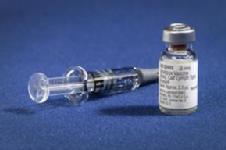Here we focus on elements of our research that have had a significant impact beyond the academic community. We have tried as much as possible to produce descriptions that are suitable for general audiences; more detailed scientific information can be found on the activities page.
| Foot and Mouth Disease. Members of WIDER have been involved in the UK foot-and-mouth outbreaks in 2001 and 2007, and have help the UK government in controlling this devastating infection. In the UK, we have developed sophisticated mathematical models that can capture the spatial spread of infection and that can be used to predict the effects of a range of control options in simulations - rather than experiment in the real world. We have also developed statistical software to determine the risks of (currently un-diagnosed farms) being infected. Internationally, we have been involved with scenario planning in both Denmark and USA, to assist with determining likely outbreaks and optimal control measures. |
 |
 |
H1N1 Swine Flu. Members of WIDER were heavily involved in the UK planning and preparedness during the 2009 swine 'flu outbreak. This involved critical scientific assessment of the lastest data from UK and around the world, together with the development of mathematical models to forecast the likely future cases and the impact of controls such as school closures or vaccination. This public health work is ongoing, with plans for future pandemics being revised in response to lessons learned. |
| Honeybee Diseases. Pollinators, such as honeybees, provide vital pollination services both to agriculture and to wild plant populations. The global value to agriculture alone was estimated at €153 billion in 2005. However, honeybee populations are threatened by a number of endemic and emerging diseases. Working closely with the National Bee Unit (part of the Food and Environment Research Agency, or FERA), WIDER is investigating the historic spread of pests and pathogens to better inform future control policies. |
 |
 |
Vaccination in the UK. The MEMVIE project (Mathematical and Economic Modelling for Vaccination and Immunisation Evaluation) uses the latest mathematical and statistical methods to assess the associated costs and benefits of changes to the UK national vaccination programme. We develop state-of-the-art models that are matched to epidemiological data; results from such models are then assessed, economically calculating the costs of vaccination programmes and the associated health benefits. Results are presented regularly to the Joint Committee on Vaccination and Immunisation (JCVI), which advises the UK government on changes to vaccination strategy. |
|
Neglected Tropical Diseases . Neglected Tropical Diseases (NTDs) cover a range of infections that affect populations in low- and middle-income countries. The control of these infections require detailed predictive models, so that the controls can be optimised. Funded by the Bill & Melinda Gates Foundation, the NTD modelling consortium attempts to address the critical question: "Can we achieve the World Health Organisation 2020 goals, using current methods?". Results from this project will help shape the fight against NTDs over the coming decade. . Neglected Tropical Diseases (NTDs) cover a range of infections that affect populations in low- and middle-income countries. The control of these infections require detailed predictive models, so that the controls can be optimised. Funded by the Bill & Melinda Gates Foundation, the NTD modelling consortium attempts to address the critical question: "Can we achieve the World Health Organisation 2020 goals, using current methods?". Results from this project will help shape the fight against NTDs over the coming decade.
|
 |
 |
Footrot. We are investigating this infectious cause of lameness in sheep. Our approach takes two strands. We are working with farmers to identify how footrot can best be controlled now, and our work highlights that farmers can reduce levels of lameness to <2%; the level of lameness in England has fallen from an average of 10.6% to 4.9% since we started our research in 2000. We are also studying Dichelobacter nodosus, the causative agent of footrot, to understand the interactions between host, environment and pathogen that enhance transmission. |
Bovine Tuberculosis. Bovine tuberculosis (bTB) is one of the most complex, persistent and controversial problems facing the UK cattle industry, costing the country an estimated £100 million per year. Ongoing work in WIDER has developed a simulation model for the spread and control of bTB in Britain, that accounts for multiple risk sources. The model accurately captures the recent spread and rise in detected cases, and makes it possible to assess the potential costs and benefits of a range of control measures.
|
 |








